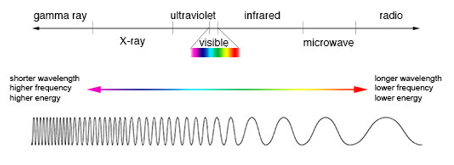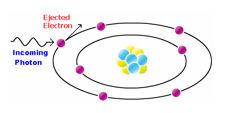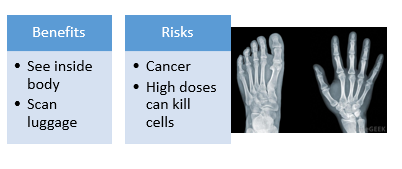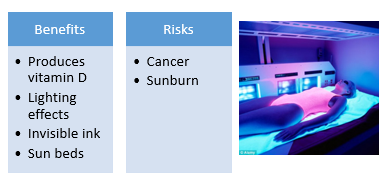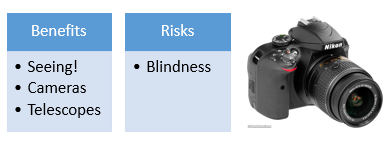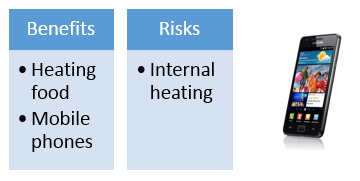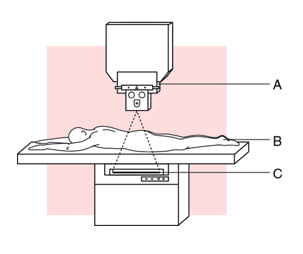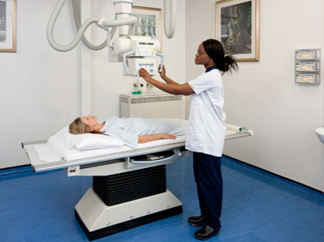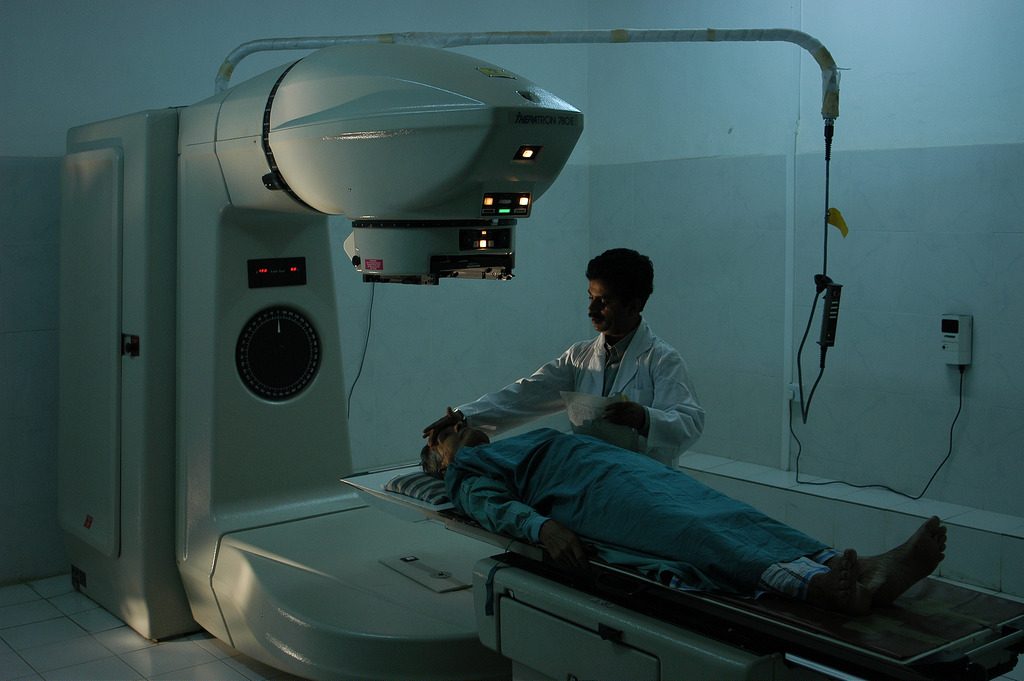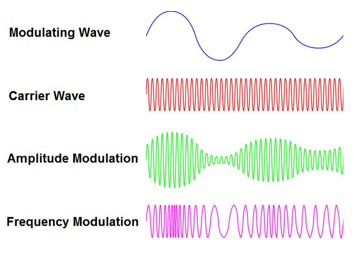Contents
Electromagnetic Spectrum
Electromagnetic Spectrum
The spectrum of visible light consists of 7 colors (red - violet). However, the electromagnetic spectrum extends beyond both red and violet, making it invisible. The electromagnetic spectrum refers to this wider range of wavelengths.
Electromagnetic waves are transverse waves that travel at the speed of light through a vacuum.
Some types of radiation have enough energy to remove electrons from atoms, a process known as ionization. Ionizing radiation can damage cells and potentially lead to cancer. In high doses, it can even kill cells.
Gamma rays, X-rays, and ultraviolet radiation are examples of ionizing radiation.
It is important to be familiar with the uses and risks associated with each type of radiation.
Gamma:
X-rays:
Ultraviolet:
Visible Light:
Infra-red:
Microwaves:
Radiowaves:
Infra-Red
All objects emit and absorb infrared (IR) radiation. The higher the temperature of an object, the more infrared radiation it emits in a given time.
A body (object) at a constant temperature emits the same amount of radiation that it absorbs.
The amount of radiation entering or leaving a body determines its temperature.
Dark, matte colors are best at absorbing and emitting IR radiation.
Light, shiny surfaces are more likely to reflect IR radiation.
A 'black body' absorbs all the radiation it receives and does not reflect or transmit any radiation. It is also the best possible emitter of radiation.
An object at a constant temperature emits a range of wavelengths of radiation. The peak intensity emitted depends on the temperature. As the temperature increases, the intensity at every wavelength increases and the peak intensity will be at a shorter wavelength.
Non-ionising Radiation
Non-ionising radiation cannot cause cancer, although there may be other risks associated with it.
Visible Light
Benefits:
- Allows us to see
- Used in cameras
- Used in telescopes
Risks:
- Prolonged exposure can cause blindness
Ionising Radiation
Ultraviolet
Ultraviolet radiation is produced by very hot objects. Most of the UV radiation we are exposed to comes from the sun. UV radiation is absorbed by the skin.
Benefits:
- The skin absorbs UV radiation and produces vitamin D
- UV radiation can improve mood by causing the body to release certain chemicals
- UV exposure can cause the skin to tan, which some people see as a benefit
Risks:
- Excessive exposure can cause sunburn
- Long-term exposure increases the risk of skin cancer
X-Rays
X-rays can pass through soft tissue but not through denser materials like bones. This property is used to develop images of bones or to view the inside of luggage at an airport.
Exposure to X-rays increases the risk of cancer. However, for patients, the benefit of having an X-ray to obtain an accurate diagnosis outweighs the very small increased risk of cancer. Precautions are necessary for medical staff who work with X-ray machines to prevent high levels of exposure:
Precautions:
- Only use X-rays when necessary
- Target specific body parts
- Operate the machine from a separate room or behind a lead-lined screen
Gamma Rays
Gamma rays are released from the nucleus of radioactive materials.
In medical imaging, a patient swallows or has a gamma tracer injected into their bloodstream. A gamma camera detects the gamma radiation emitted from the body, producing an image of the body parts containing the tracer.
Ionising radiation can be used to kill cancerous cells in a process called radiotherapy. The radiation is targeted at the tumor, but some damage to healthy cells is inevitable.
Risks
Every activity carries some level of risk (e.g., crossing the road or drinking a glass of water). People engage in activities if they believe the benefits outweigh the risks.
Perceptions of risk can be complex. For example, a person may perceive the risk of skin cancer from sunbeds as low because it is invisible and long-term. This perception may lead them to take the risk for the short-term benefit of a tan.
Required Practical – Infrared Radiation
To investigate the radiation emitted from different types of surfaces, a Leslie cube can be used. The Leslie cube is filled with hot water, and the temperature is measured at each side (shiny/dull/white/black) over a period of time. An infrared thermometer is used to measure the temperature, and it is important to keep the thermometer at the same distance from each side.
The results of the experiment should confirm that dark/matte surfaces emit the most IR radiation.
Microwaves
Microwave radiation can be used to heat food:
- Microwave radiation is absorbed by water molecules in the food
- Water molecules heat up, turning into steam
- Hot water/steam heats the food
- Internal heating occurs, making it faster than a normal oven
Microwave radiation is also used for mobile phone communications. However, the frequency of microwave radiation used for mobile phones is different and cannot be used to cook food. Some heating of the brain does occur when using a mobile phone, but there are no short-term risks associated with this heating. The long-term risks of mobile phone use are still unknown as they have only been in widespread use for the last 20-25 years.
Radiowaves
Radiowaves are used in astronomy and for communicating signals from one location to another.
Information can be carried by a radio wave by modulating a carrier wave. The input signal is an alternating current, which is used to vary the amplitude or frequency of a carrier wave (this is called modulation). Amplitude modulation (AM) signals can be transmitted over longer distances but have lower quality. Frequency modulation (FM) signals have higher quality but cannot travel as far.
The radio waves are absorbed by an aerial, producing an alternating current in the receiver. The original signal is then separated from the carrier wave.
- Which of these types of radiation is ionizing? Ultraviolet, Microwaves, Visible light, Infra red
- Ultraviolet
- Which of these types of radiation is non-ionizing? Radiowaves, Gamma rays, X rays, Ultraviolet
- Radiowaves
- Which type of electromagnetic radiation has the shortest waves? Gamma Rays, Radio waves, Infra red, Ultraviolet
- Gamma rays
- Which type of electromagnetic radiation has the longest waves? Radio waves, Gamma Rays, Infra red, Ultraviolet
- Radiowaves
- Which type of radiation is used by mobile phones?
- Microwaves

